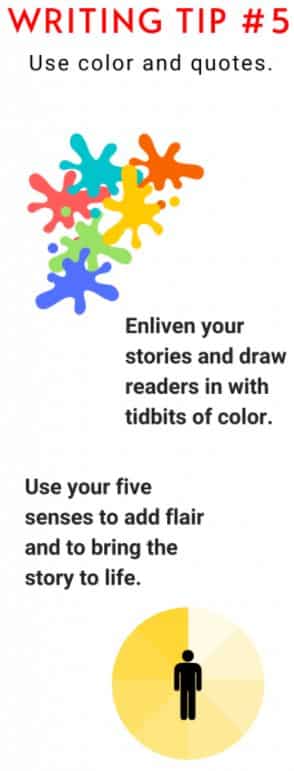Writing is a process. Follow these tips to create original, credible and balanced journalistic articles and multimedia stories.
By News Decoder

Writing is a process.
At school, more often than not you write a paper, submit it, receive a grade and then move on to the next piece of work. Writing for News-Decoder is not like that.
A first draft is just that: a draft. Expect to rewrite it. The second draft may look nothing at all like the first draft. The third draft may not resemble the second. It’s part of the writing process. Don’t be hard on yourself because you don’t strike gold in the first draft. First drafts are supposed to be rough and imperfect.
To save yourself time and trouble, before writing a first draft, summarize your thoughts — Just what am I trying to say? — and send a précis to News-Decoder for feedback.
The feedback may help you refine your approach. It might prompt you to do research you had not considered. It might encourage you to get out and dig up information to support your argument. If you cannot boil your main argument down to 50 words or less, you probably don’t quite know what you want to say.
The feedback may help you refine your approach. It might prompt you to do research you had not considered. It might encourage you to get out and dig up information to support your argument. If you cannot boil your main argument down to 50 words or less, you probably don’t quite know what you want to say.

Show, don’t tell.
When writing, especially in the first person (“I”), let the story do the talking. Avoid telling the reader what they need to know. Let the story do that. Avoid sweeping conclusions. The reader will draw the correct conclusions.
In other words, you can lead a horse to water, but you can’t make them drink. Show the reader where the water is. They’ll drink if they want to.
Think of a fable by Aesop or de La Fontaine. The tortoise outruns the hare, the ant stores food and the grasshopper begs, the fox flatters and the crow sings. Imagine if the author had simply tried to tell you the moral. How boring. Like telling someone why a joke is funny.

Consider other viewpoints.
You see things a certain way, and you might even be convinced you are right. You might be outraged over an indignity or an abomination. But to change things, you need to understand the other side.
There’s a reason schools used to teach debating — to help students understand that an argument is only as strong as its weakest link, and that the strongest argument examines the counter-argument to better undermine it.
Don’t assume that you are right. Question your assumptions and biases. Listen to the other sides. The world’s most intractable problems require compromise, and compromise is not imposed by one side on another.

Support your view with data.
Your personal view is unique and important. But it is probably not enough. Your passion and emotion might convince you, but they won’t necessarily convince a reader.
Often, a young writer describes a personal experience and extrapolates to draw general conclusions about a region, a country, a group. Beware. Your personal perspective may be very partial — a bit like a blind-folded person with one hand on an elephant.
Dig deeper. Is there data that addresses the situation or circumstances you are writing about? Sociologists spend their time collecting data about societies, behavior, attitudes. Academics write entire books about the very questions you may be asking yourself. Find the expert out there. That’s what journalists do — they spend much if not most of their time chasing down the experts.
I am not saying that your personal reflections are not valid. But test them against data. Question your own assumptions. If you’re right and you have data to prove it, then your experience will resonate more widely.

Use color and quotes.
The best journalists use color and quotes to enliven stories, draw readers in, bring situations to life. It’s not a technique that is taught in many classrooms, where the emphasis can be on research skills and critical thinking, but it’s what news readers want and expect.
Color is nothing more than a journalist using their five senses and conveying the sensations to the readers and viewers. Anyone can write about a subject from afar without even getting away from one’s computer. But a journalist adds authenticity and flair to a story by including tidbits of color.
After Muhammad Ali died, I asked News-Decoder’s correspondents if any of them had any thoughts or stories they would like to tell. Charlie Aldinger, who covered desegregation in the U.S. South in the 1960s for UPI, raised his hand, noting that he had covered Ali’s first heavyweight championship fight against Sonny Liston in 1963.
So here’s the start of the first sentence in the fourth paragraph in Charlie’s story: ”My white shirt was speckled with Liston’s blood …”
Anyone could write about Ali’s tremendous legacy. But only a ring-side observer of that fight had red blood on their white shirt.
The same goes for quotes. They put the reader or viewer right in front of the speaker, with no mediator. They lend immediacy and authority to the story.
But to gather color and quotes, you must get out and about. You can find only so much inside of the Internet. To be distinctive, go out and discover for yourself.
